by Naomi L. | November 20, 2013 | Blog, Creative Writing, Notable Authors |
I’ve been feeling a little nostalgic lately: looking through my books for old favorites, watching movies from my childhood whenever they’re on TV, even listening to songs from the ’90s once in a while. That’s how I recently had an idea for another post on inspiration, because when I think about my childhood, one of the most prominent figures that comes to mind is the author of some of my favorite classics of children’s literature: Dr. Seuss.

Theodor Geisel in 1957
Bio
Name: Theodor Seuss Geisel
Pen Name: Dr. Seuss
Life: Mar. 2, 1904 – Sept. 24, 1991
Gender: male
Nationality: American
Occupation: writer, cartoonist, animator, publisher, artist
Genres: children’s literature
Notable Works: The Cat in the Hat, Horton Hears a Who!, Green Eggs and Ham
My Favorite Works: The Cat in the Hat, The Sneetches and Other Stories, Horton Hears a Who!, How the Grinch Stole Christmas!
Inspiration
Dr. Seuss was a huge part of my childhood. When I was little, my mother signed us up for the Dr. Seuss book club, so we would get one of his books in the mail every month. By the time I started reading on my own, I had a large collection of fun stories to choose from, such as The Cat in the Hat, Horton Hears a Who! and Green Eggs and Ham. Because of this, my earliest memories of reading were filled with colorful characters and silly rhymes that kept me entertained for hours on end. If I ever wanted to get lost in books, I could always count on Seuss’s imaginative world.
The main reason I find this author so inspiring is because his stories were an important first step into my love of books. Sometimes I wonder if I would have grown to love reading as much as I do today if I hadn’t had the privilege of enjoying Dr. Seuss’s work at such a young age. His books were very easy to read and understand, and that always made reading such a pleasure. In fact, his rhymes and style of writing were so memorable that to this day, my mom and I can quote lines word for word back to each other. In this way, Seuss gave us the gift of memories that we could share for the rest of our lives.
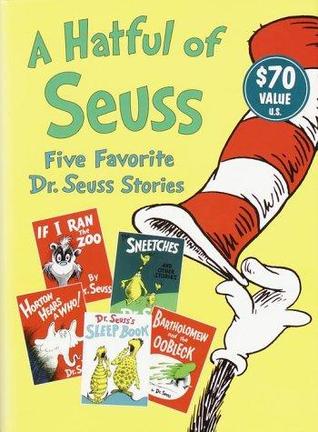
A Hatful of Seuss: Five Favorite Dr. Seuss Stories
But there was much more to these books than simple rhymes and oddly shaped characters with bizarre names. Dr. Seuss had a talent for embedding important lessons in his stories without making them blatantly obvious or patronizing. Moral issues are cleverly hidden behind tales of strange creatures living in unusual worlds: The Sneetches shows us that racism is unjustified; The Lorax shines light on environmentalism and the dangers of corporate greed to the natural world; How the Grinch Stole Christmas! criticizes the commercialization that the holiday season has suffered over time; and even a story as simple as Green Eggs and Ham can be read as a lesson on trying new things in order to form educated opinions. There was almost always something to learn in Seuss’s books, and because the lessons were presented in such a kid-friendly format (complete with his colorful illustrations), it made his stories that much more accessible to children just starting to discover the world around them.
There are quite a few authors I associate with my childhood, but Dr. Seuss is by far one of my favorites. His books inspired me to continue reading beyond the beginner level, and the lessons in his stories have stayed with me into my adult years. Even now, I can’t help but smile as I think about how I once knew The Sneetches by heart and how I still enjoy reading Horton Hears a Who! out loud once in a while. Though authors like Roald Dahl and J.K. Rowling were great inspirations for my writing, Dr. Seuss was a great inspiration for my reading, and in my opinion, there’s no greater gift that a writer can give to children. To the little girl still in my heart, Dr. Seuss will always be a hero.
by Naomi L. | October 23, 2013 | Blog, Creative Writing, Featured |
Remember the elementary school days when our teachers introduced us to those trusty reference books that would guide us through our writing? These were the friends we would come to rely on for the rest of our lives, the books containing so many of the answers we would need to survive our school years. The dictionary told us what those long words we’d never seen before meant. The atlas helped us find those faraway places we’d heard about in Geography class. There were encyclopedias and almanacs full of facts that came in handy for homework assignments. And then there was that book that gave us lists of synonyms and antonyms for the words we wanted to use in our writing: the thesaurus.
This last book is an interesting case, though, because unlike the others, it has the same potential to hinder as it does to help. Yes, the thesaurus is a top go-to resource for many writers, especially beginners looking to enhance their work. However, something our teachers may have neglected to tell us is that the guide comes with unwritten instructions: use knowledgeably.
Trustworthy/reliable friend/ally?
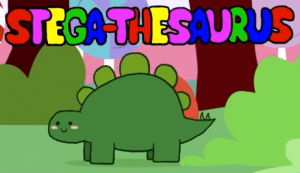
“Hooray yay for synonyms!”
(Screenshot from RubberNinja‘s Gameoverse videos)
When we were first introduced to the thesaurus, we were taught that it’s a great resource for helping to expand our vocabulary, and that’s true. I can’t even count how many new words I’ve learned just by looking up synonyms for ones I already knew. Every time I work on my stories, I have my dictionary/thesaurus widget handy to help me find replacements for words that would otherwise be repeated too soon in the narrative. It even helps me remember advanced vocabulary that I may have forgotten (which happens more often than I’d normally care to admit).
A good use of a thesaurus is as a reverse dictionary. You know how sometimes you know exactly what you mean to say, but you just can’t find the right word for it? Well, all you have to do is look up more common words for the definition you want and see what options come up. True, this method may not be as effective as using an actual reverse dictionary, which has full definitions and cross referencing, but it’s still a convenient alternative to find simpler examples, especially for writers who don’t have access to a more complete guide.
So yes, writers, the thesaurus is your friend. It will save you from plain and repetitive writing, and can teach you a thing or two (or ten) in the vocabulary department. But be warned, because placing too much trust in this guide can have negative consequences as well…
Or dubious/suspicious enemy/foe?
So how could this dependable friend of ours also be a hazard to our writing? Instead of launching into a dissertation about the dangers of overusing a thesaurus, allow me to illustrate the point instead with an example from the popular TV series Friends. In this episode, Joey wants to write a letter of recommendation for Monica and Chandler, who are planning to adopt. When he mentions that he wants to make it sound smart, Ross suggests he use a thesaurus to replace plain words with advanced ones. Unfortunately, the results are less than satisfactory…
Joey: Hey, finished my recommendation. (hands a letter to Chandler and Monica) Here. And I think you’ll be very, very happy.
[…]
Chandler: I don’t, uh, understand.
Joey: Some of the words a little too sophisticated for ya?
Monica: It doesn’t make any sense.
Joey: Of course it does! It’s smart! I used a the-saurus!
Chandler: On every word?
Joey: Yep.
Monica: All right, what was this sentence originally?
Joey: Oh, “They are warm, nice people with big hearts”.
Chandler: And that became “They are humid, prepossessing Homo sapiens with full-sized aortic pumps”?
Joey: Yeah, yeah. And hey, I really mean it, dude.
– Friends (Season 10, Episode 5 – The One Where Rachel’s Sister Babysits)
As you can see, Joey’s overuse of a thesaurus causes him to turn out a ridiculous stream of long words that have nothing to do with what he wants to say. While Ross’s advice may have been good in theory, he probably should have warned Joey not to go straight for the “smartest sounding” word every single time. The problem wasn’t just that his letter would come out overly “purple“, but that there was an important tip he neglected to keep in mind when choosing synonyms: context is key.
A notable example of a misused synonym in the above dialogue is “humid”. As we all know, while “warm” and “humid” have comparable definitions when it comes to describing the weather, only “warm” is also applicable to people. A similar problem happens with the use of Homo sapiens, which is only good for scientific writing and doesn’t really work as an alternative for “people”. With all these big words so out of place, it’s no wonder Monica and Chandler couldn’t understand anything Joey had written!
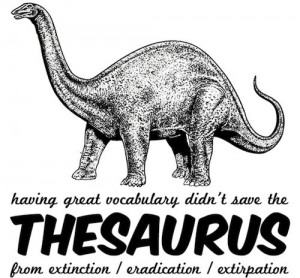 But there’s another problem with placing too much trust in a thesaurus. Although the purpose of the guide is to index words with similar definitions, there’s a catch: the “synonyms” that come up don’t always have the exact same meaning. This means you should always be aware of the full definition of a word before you try to pass it off as a replacement for a more common one, advice that many writers fail to take into account.
But there’s another problem with placing too much trust in a thesaurus. Although the purpose of the guide is to index words with similar definitions, there’s a catch: the “synonyms” that come up don’t always have the exact same meaning. This means you should always be aware of the full definition of a word before you try to pass it off as a replacement for a more common one, advice that many writers fail to take into account.
One particularly embarrassing example of this practice from my own experience is when I used the word “fortuitous” incorrectly in a story. My thesaurus listed it as a synonym for “random”, but what I didn’t realize until after publishing the piece was that while “random” is a neutral word, “fortuitous” usually has a positive connotation (as in “good fortune”), which was not the feeling I intended to convey. Fortunately, no one ever called me out on it, but it was still embarrassing to know the mistake was out there for anyone to see. So to be safe, make sure you look up the definition of a synonym before you use it in your writing. You’ll be glad you did.
A thesaurus can be a friend or an enemy, depending on how much faith a writer is willing to invest in it. While its uses are mostly beneficial, it’s up to you to make sure that this trusted ally doesn’t turn on you and muddle up the meaning behind your words. It’s OK to trust your thesaurus to help you enhance the vocabulary in your writing. Just try not to use it in excess!
Monica: Hey, Joey, I don’t think we can use this.
Joey: Why not?
Monica: Well, because you signed it “Baby Kangaroo Tribbiani”.
What about you? Do you make good use of your thesaurus? Has it been more of a help or a hazard to your writing?
by Naomi L. | October 18, 2013 | Blog, Indie Writer Spotlight |
Hello, dear readers! Today I’m sharing a special post, as it marks the beginning of a new segment on my blog: the Indie Writer Spotlight! Though it won’t be a regular segment, posts will be up on Fridays and will feature independent authors and their books in the world of self-publishing. With so many writers trying to get their work out there, it’s great when we can support each other!
Kicking off the Indie Writer Spotlight is an interview with Jennifer M. Zeiger, one of the authors of the upcoming short story anthology Midnight Abyss. Jennifer and I have been in touch for the past few weeks, and I sent her some questions about the new book. Here’s what she could tell me about Midnight Abyss. Enjoy!
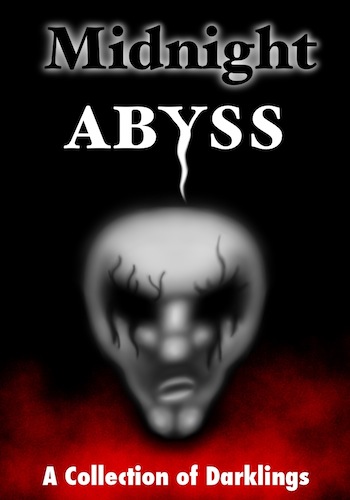
 About Jennifer M. Zeiger
About Jennifer M. Zeiger
Jennifer M. Zeiger lives in the beautiful state of Colorado with her husband, dog and two cats. She graduated with her Bachelors in English in 2008 with minors in Accounting and Recreation. She loves writing fantasy in particular but will read just about anything.
Interview with Jennifer
Me: What can you tell me about the book itself?
Jennifer: The book’s titled Midnight Abyss. It’s a mix of horror and dark fantasy short stories with a few poems thrown in too (It’s Midnight in the Abyss. Do you know where your Darklings are?). If you can’t tell, we’re having a lot of fun with this. =)
Me: Who are the collaborating authors, and where are you all from?
Jennifer: Okay, this one’s going to take a minute. There are nine authors all told. We have Anisa A. Claire in Vancouver and Kelleigh in Seattle who are the masterminds of all of this.
Then there’s Doug Langille in Nova Scotia who, thankfully, knows the techie stuff.
Gregory K Shipman’s up in Alaska. He keeps us all laughing when we start taking things too seriously.
Shaun Adams charms us all with his British accent since he’s from the Isle of Wight in England.
Raymond Tabaygo’s a hero of mine. He’s in New Jersey and he’s 66 years old and still writing. I love it.
Matthew X. Gomez is in Maryland. Although we’ve all helped with the editing, he’s definitely the one willing to cut your writing to pieces. It’s great.
Then, to finish this all off, there’s Theresa Briscoe Tschetter and I in the old west. She’s in Wyoming and I’m in Colorado. Theresa, even though she’s had some trouble with internet since we’ve started working on this, has made a massive effort to stay involved and upbeat. As for myself, I feel like I’m along for the ride and it’s a great adventure. =)
Me: How did you all meet?
Jennifer: Except for Anisa and Kelleigh, I think all of us met on Writer’s Carnival, which is a workshop site for writers. We’ve never met face to face. It boggles my mind how, in this day and age, such collaboration can happen without actually meeting.
Me: What made you decide to write a short story anthology together?
Jennifer: I received a message from Anisa asking if I wanted to take part in writing this anthology. I think the idea came about because we were all familiar with each other’s writing off of Writer’s Carnival and we all liked what we saw.
Me: And why did you decide to write in the horror and dark fantasy genres?
Jennifer: Those are the two genres we all like to write in. Well, fantasy for me is the genre I prefer, so dark fantasy was a bit of a challenge, which was great. Plus, we decided to launch the book on Halloween, so those two genres fit the theme.
Me: How long did it take you all to put the book together?
Jennifer: I received the email at the end of July asking if I wanted to be a part of this. Honestly, we lagged during August. Then about mid September, we realized, ‘oh dear, our deadline’s fast approaching!’ So we all kicked it in gear and have been working furiously since the last couple weeks of September. So when all is said and done, we put in about six weeks to finalize the stories and put the book together, which is wicked fast but we’ve managed to come up with a book we all love.
Me: Was it difficult coordinating your efforts, since most of you live so far apart?
Jennifer: Yes and no. Sorry, that’s an awkward answer.
Yes, because we’re working through messages and the occasional Google Hangout. There’s a lot of information getting thrown around: slogans, covers, order of stories, editing details… I could go on for a very long time. Let me just say, Dropbox is awesome.
But when I really look at how much we’ve figured out in a very short period of time, I have to say the group’s fantastic. There could be a lot of bickering but there hasn’t been. We all want this book to be the best set of short stories that we can produce and we’ve worked really hard to make that happen.
Me: How did you feel while working on this book?
Jennifer: Oh Lordy, that’s a loaded question. Personally, I’ve never been published before, so I’m thrilled-out-of-my-mind excited, I’m scared so bad my hands shake if I think about it too long and I’m breathless trying to keep up with all the details. But overall, I’m blessed to be working with such great people and following my dream at the same time.
Me: And how do you feel now that it’s all done?
Jennifer: Wow, that was a wild ride! And still is. Unlike with traditional publishing, we don’t have a marketing team working with us, so we’re still working on getting the word out. That work won’t be done for a while, but having a finished product feels amazing. Holding a hard copy book with my name on it, indescribable.
Me: When can we expect a full release of the book?
Jennifer: Oct. 31st to coincide with Halloween.
Me: Where can we find out more about the book?
Jennifer: Facebook: Midnight Abyss
Twitter: @AbyssMidnight
Goodreads: Midnight Abyss (I believe we’re going to do some giveaways for reviews here, so that’s definitely something to look forward to.)
Tumblr: TheMidnightAbyss.tumblr.com
My blog: Jennifer M Zeiger
We’ve set the book up with Amazon’s CreateSpace. So if you’re looking for a copy, you can find it there after the 31st.
Thanks so much for the interview, Jennifer! And thanks to you readers for joining us in the Indie Writer Spotlight!
Midnight Abyss comes out October 31st. Be sure to check it out this Halloween! Thanks for reading!
by Naomi L. | September 18, 2013 | Blog, Creative Writing, Writer's Toolkit |
Who among us writers hasn’t found themselves doubting at one time or another whether the grammar in our writing was correct? I myself have at least three doubts regarding the previous sentence in this paragraph! We’ve probably all been in this situation before, getting stuck during the editing process over a comma we weren’t sure was correctly placed or the appropriate formatting for a citation. That’s why today’s Writer’s Toolkit review features a nifty handbook designed to aid writers through the trials of editing and revision: The Hodges Harbrace Handbook by Cheryl Glenn and Loretta Gray.
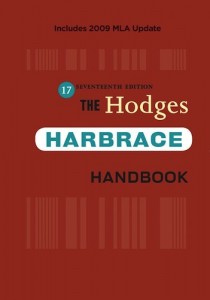

Book Summary
This handbook was one of the required materials for the online creative writing course I took through UC Berkeley. I currently own the 17th edition, published in 2009 with an MLA update, though at the time of writing this review, an 18th edition has already been released (and you can be sure that more will follow).
Originally published in 1941 by English professor John Hodges as the Harbrace Handbook of English, this book has since evolved into one of the richest English writing resources available today. The contents are organized into seven parts:
- Grammar
- Mechanics
- Punctuation
- Spelling and Diction
- Effective Sentences
- Writing
- Research and Documentation
Parts are subdivided into chapters and color-coded for your convenience (sorry, I couldn’t resist). Also included are a preface by the authors outlining new features and revisions for the current edition, a glossary of usage, a glossary of frequently used terms, and an index.
Pros
The first thing one might notice upon opening The Hodges Harbrace Handbook is the table of contents printed right into the back of the front cover and the first pages. At a glance, it’s clear how thorough this manual is, covering as many topics as possible from grammar and mechanics to proper usage of English in college-level writing. The table provides a quick guide to different sections and chapters, which are colored and numbered for easy reference.
As for the actual content, I find the explanations easy to understand, bearing in mind that the book is geared toward college students and above. To add to the educational experience, practice exercises are included within chapters, as are checklists for certain cases that come up in the editing process. Other notable features are the special boxes interspersed throughout the book: “Thinking Rhetorically” invites writers to consider the impact of their writing choices on their target audience; “Multilingual Writers” notes common areas of confusion for English learners, especially those for whom English is not a first language; and “Tech Savvy” provides helpful tips for using word-processing software, a useful feature for writers of the digital age. The last pages of the handbook include indexes for “Multilingual Writers” boxes, checklists and revision symbols.
One of my favorite details about the most recent editions of The Hodges Harbrace Handbook is the update for writers of modern times. As of the 17th edition, a new chapter titled “Online Writing” is included in the “Writing” part of the guide, and revisions reflect updates to MLA and APA guidelines and an expansion to a chapter on using writing software for business. Because of these updates, I would strongly advise against purchasing any edition of this handbook earlier than the 17th, published in 2009.
Cons
Honestly, this list is pretty short. In fact, the first issue I found with this handbook may have been due to error on my part. There were a couple of questions for which I couldn’t find answers in the handbook, either because I was searching for them in the wrong chapters or because they simply weren’t there. Also, the preface mentions some supplemental materials that are only available when bundled with the handbook at an additional cost. Not exactly a downside, but just a point to keep in mind if you’re looking for a complete learning experience to go with this guide.
Oh, and of course there’s the matter of price. A new latest-edition hard copy goes for over $80 on Amazon, which may seem steep to a student who only plans on using it for a semester. On the other hand, a prolific writer who needs to constantly edit and revise their work would probably find any price under $100 quite reasonable. As with any product, it’s all a matter of whether or not you feel you’d be able to get your money’s worth out of it.
Summary
Pros
- Versatile and thorough guide to the English language
- Well-organized contents
- Easy to understand
- In-chapter practice exercises
- Special boxes for “Thinking Rhetorically”, “Multilingual Writers” and “Tech Savvy” tips
- Extra indexes for “Multilingual Writers”, checklists and revision symbols
- Updated edition for writing in the modern age
Cons
- Possible missing information
- Supplemental materials available at additional cost
- Price ($80+ new on Amazon)
Conclusion
I highly recommend this handbook to any writer who puts as much effort into editing as into writing, if not more. Though I purchased my copy as a requirement for a class two years ago, I have since found it quite helpful when revising my work, and continue to use it today. Whether you’re looking for a complete guide to basic grammar or a full learning experience in the English language, The Hodges Harbrace Handbook is a great resource to keep handy, as much for the student writing for college as for the creative individual writing for life.
by Naomi L. | September 4, 2013 | Blog, Creative Writing, Off The Bookshelf |
Since the 9th century, the legend of King Arthur has been a well-known and popular one, spawning several myths and original retellings around the world over hundreds of years. Today, modern adaptations of Arthurian legend are hardly in short supply, from fantasy fiction portraying tales of the Knights of the Round Table to historical nonfiction seeking the truth behind the myths. Among the Arthurian fantasy novels that stand out the most, however, is Marion Zimmer Bradley’s celebrated four-part saga: The Mists of Avalon.
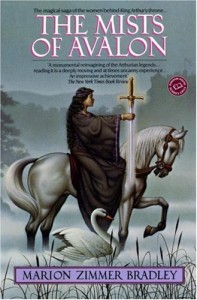
The Mists of Avalon, by Marion Zimmer Bradley
Summary
The novel series was first released in the United States by publisher Alfred A. Knopf in January 1983, for a targeted audience of adults, particularly women of any mature age. The Mists of Avalon tells the story of the rise and fall of King Arthur Pendragon in Britain during the late 5th and early 6th centuries, spanning across generations to narrate events from a little before his birth to sometime after his death. While it still encompasses many of the legend’s fantasy elements so well known today, the saga has a creative twist in that it relates the entire Arthurian legend from a completely different perspective: that of the female characters.
Review
As excited as any admirer of medieval fantasy fiction may be to start on a novel series with an Arthurian theme, the sheer length of this saga may prove daunting enough to warrant it a place on a summer reading list instead. This would likely turn out to be a wise decision, for one quickly discovers that Bradley’s elaborate plot, complex characters, detailed descriptions of medieval Britain, and fantastically original perspective of the Arthurian legend are capable of making the novels nearly impossible to put down for periods longer than are enough for basic necessary tasks, such as eating and sleeping. It’s arguable that enraptured readers would probably reach the end of the book well before the aforementioned list’s respective summer is over, and somehow feeling more conscious of – and respectful toward – the many possible interpretations of the story of King Arthur.
One of the most obvious themes that sets this novel apart from other Arthurian adaptations is feminism. The most widely known versions of these myths portray King Arthur and the Knights of the Round Table as the heroes of the story, while the women remain further toward the background as supporting characters with only a few key roles. In The Mists of Avalon, it’s almost exactly the opposite; Arthur and the other male characters sink into supporting roles, while the women rise up to become the protagonists in this original retelling. Readers are brought into the same world they know so well from the classic tales of King Arthur, yet at the same time, it becomes an entirely different world altogether, proving that vantage point really does make all the difference in the telling of a story.
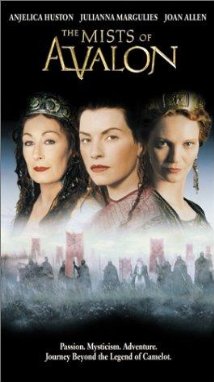
The Mists of Avalon (2001 TV Movie)
The majority of the narrative is told from the perspective of Arthur’s half-sister: the Avalon priestess Morgaine (known as Morgan le Fay in other Arthurian tales). Many chapters are also narrated from the viewpoints of other important women, among them Arthur’s wife, Queen Gwenhwyfar (the Welsh spelling of ‘Guinevere’); Avalon High Priestess and Lady of the Lake, Viviane; and Arthur and Morgaine’s mother, Igraine. Not only are these characters graced with much longer periods in the center of the narration, but Bradley also does a wonderful job of pulling these women out of their original unidimensional roles and giving them true depth, making them worthy of protagonism. Morgaine is no longer just an evil witch or a simple healer, but a strong druid priestess with good intentions and a tragic destiny. In turn, Gwenhwyfar’s innocent Christian veil is not just a plain matter of faith, but a slow descent into fanaticism brought on by an inferiority complex, her inability to bear children, and her search for salvation from her not-so-innocent infatuation with her husband’s best knight.
Which leads into the next main theme of the book: religion. One of the basic historical aspects of the Arthurian legend is the Christianization of Anglo-Saxon England, at a time when paganism was equally common. Again, a new light is shed on the story, as the conquering over dark pagan ways by Christianity becomes more of a struggle of rising tension and intolerance of the increasingly unstable balance between religions. The matriarchal society of Avalon is cast onto the defensive side against the overbearing patriarchal Church, eventually leading into a sequence of events in which Morgaine and the pagans strive to save Avalon and their native religion from disappearing from their country’s history altogether. Obviously, such strong religious implications – as is true of many novels with similar themes, notably Dan Brown’s The Da Vinci Code and Philip Pullman’s His Dark Materials trilogy – tend to spark equally strong criticism from religious groups, likely qualifying this book for a more “tolerant” audience.
Many might argue that it takes a certain kind of reader to enjoy a story like this, which boasts a generous share of heavy mature themes, such as sexuality and political radicalism. In light of such arguments, it may be best to recommend the series to readers deemed mature enough to refrain from dwelling excessively on these superficial themes (key as they are in many parts of the narrative) and truly appreciate the central concept Ms. Bradley intended to portray in her books: a story isn’t necessarily a simple matter of black and white or good and evil, but instead may hold several truths.
Inspiration
I first read this series when I was 14, after my mother gave me the single four-part volume as a Christmas gift. Since immersing myself in the world of Avalon, this saga has inspired me for its unique take on the legend of King Arthur, a story that has always fascinated me for its fantasy themes and insights into Celtic mythology. It was interesting to read this classic tale from the perspective of the women, and I quickly became entranced by the core theme of feminism present throughout The Mists of Avalon. Looking back, I’m glad my mom considered me mature enough to read the novels during my adolescence, for they introduced me to major political and religious topics during a key stage in my development as an independent thinker, and have thus become a great inspiration for the subtexts and themes that I like to write into some of my own stories.
The Mists of Avalon is, in my opinion, a classic work of art. Whether you’re an Arthurian enthusiast, a feminist, an intellectual with a fascination for religious debate, or simply a fan of well-written fantasy fiction, you will most likely enjoy this book. And if you happen to fit into every one of the above categories – as this writer likes to think she does – you will certainly devour it in no time, and still be left hungry for more.




 But there’s another problem with placing too much trust in a thesaurus. Although the purpose of the guide is to index words with similar definitions, there’s a catch: the “synonyms” that come up don’t always have the exact same meaning. This means you should always be aware of the
But there’s another problem with placing too much trust in a thesaurus. Although the purpose of the guide is to index words with similar definitions, there’s a catch: the “synonyms” that come up don’t always have the exact same meaning. This means you should always be aware of the 
 About Jennifer M. Zeiger
About Jennifer M. Zeiger




Recent Comments